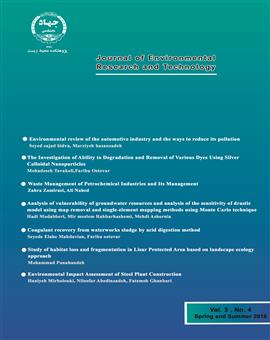The Investigation of Ability to Degradation and Removal of Various Dyes Using Silver Colloidal Nanoparticles
Subject Areas : Pollution of water resources
Mohadeseh Tavakoli
1
,
Fariba Ostovar
2
![]()
1 - Islamic Azad University
2 - Faculty member of Environmental Research Institute of ACECR
Keywords: PollutantDyeAg NanoparticleColloid Destruction,
Abstract :
Colors are one of the most important pollutants of water, and only one entry into the water can significantly reduce the quality of water. In addition, due to the synthetic origin and the presence of complex molecules in the structure of colors, the purification process is sometimes accompanied by some problems. Colloidal nanoparticles play an important role in technology, especially in the manufacture of glass and ceramics, and are used as a suitable method for cleaning pollutants in water and wastewater. In this study, a chemical regeneration method was used to synthesize colloidal silver nanoparticles. Then, to evaluate the efficiency of synthetic silver nanoparticles, several solutions of dye and pigments such as sulfur, azo, reactive, cationic and anionic dyes were prepared and synthetic material was used for degradation of different colors. Finally, the effect of this colloidal nanoparticle on each of them was studied and compared. The results showed that silver colloidal nanoparticles have the ability to degradation and removal of methyl orange and methyl red dyes from aqueous samples, and these nanoparticles can be used for treatment the water and wastewater containing these dyes.
1. F., Hossain, o. J., Perales- Perez, S., Hwang, F., Román., 2014. Antimicrobial nanomaterials as water disinfectant: Applications, limitations and future perspectives. Science of the Total Environment, PP. 1047- 1059.
2. تکتاز، فرناز، «کاربرد نانو¬مواد آنتی باکتریال به عنوان ضدعفونی کننده آب»، ماهنامه فناوری نانو، فروردین 1393، سال سیزدهم، شماره 1.
3. جهانگیری، منصور، گرشاسبی، وحید، «تصفیه آب و فاضلاب با رویکردی بر نانو¬فناوری»، اولین کنفرانس ملی نانو¬فناوری و کاربرد آن در کشاورزی و منابع طبیعی، سال 1391.
4. A., Smith., 2009. Nanotechnology: An Answer to the World’s Water Crisis. Chemistry International, Vol. 31 ,No.4 July- August.
5. توسعه فناوری مهرویژن، «محصولات فناوری نانو در حوزه رنگ»، رزین، کامپوزیت و پلیمر، پاییز 1394، ویرایش اول.
6. سلمانی، محمد حسن، رحمانیان، رضا، دانایی، سروش، سلطانیان زاده، مریم، «ارزیابی فرآیند جذب در حذف رنگ از پساب¬های صنعتی»، دو ماهنامه علمی پژوهشی دانشکده بهداشت یزد، مرداد و شهریور 1394، سال چهاردهم، شماره سوم.
7. M. B., Miranzadeh, D., Rabbani, S., Naseri, R., Nabizadeh, S. G. A., Mousavi, F., Ghadami., 2012. Coliform bacteria removal from contaminated water using nanosilver. KAUMS Journal ( FEYZ ), Vol. 16 (1), PP. 31- 5.
8. M., Mosaferi, M., Shakerkhatibi, A., MehriBadloo., 2011. Heterotrophic bacteria in
drinking water in Tabriz, Iran. J Sch Public Health Inst Public Health Res, Vol. 8(4), PP. 83- 92.
9. جعفر قلینژاد، علیرضا، ترکیان، لیلا، دقیقی اصلی، مریم، «بررسی جذب سطحی رنگ متیل اورانژ G بهوسیله نانوکامپوزیت Ag/ CMK-3»، نشریه پژوهش¬های کاربردی در شیمی، تابستان 1394، سال نهم، شماره 2.
10. فربد، منصور، بتوندی، محمد رضا، «ساخت نانو¬ذرات نقره و کنترل آن¬ها»، مجله پژوهش فیزیک ایران، بهار 1391، جلد دوازدهم، شماره 1.
11. نوشادی، مسعود، قنبریزاده، پریسا، «بررسی کارایی اثر نانو¬ذرات نقره در گندزدایی آب آشامیدنی»، نشریه مهندسی عمران و محیط زیست، بهار 1394، جلد 46، شماره 1.
12. تجردی، آزاده، کیازاده، عسل، «مقایسه روش¬های تولید نانو¬ذرات نقره»، ماهنامه فناوری نانو، تیر 1386، سال ششم، شماره 117.
13. A., Roucoux, J., Schulz, H., Patin, 2002. Chem Rev. Vol. 102, 3757.
14. محتشمی، مهناز، سپهری سرشت، سعید، اصلی، اسماعیل، برومند، محمد علی، «سنتز نانو¬ذرات نقره با روش احیاء شیمیایی و روش بیوسنتز و بررسی اثرات ضد باکتری آنها»، مجله علوم پزشکی رازی، دی 1391، دوره نوزدهم، شماره 103.
15. L., Baia, M., Baia, W., Kiefer, J., Popp, and S., Simon, 2006. Chem. Phys. 327, 63.
16. آقاجانی معمار، فریدالدین، یزدانشناس، محمد اسماعیل، خواجوی، رامین، «بررسی روش¬هاي تولید نانوذرات کلوئیدي نقره ویک روش آسان و مؤثر جهت ضد میکروبی کردن پارچه پنبه¬اي توسط نانوذرات کلوئیدي نقره»، سومین کنفرانس ملی مهندسی نساجی و پوشاک، دانشگاه آزاد اسلامي واحد يزد، اردیبهشت 1390.


